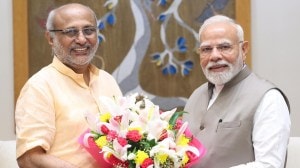We have manpower in large supply but capital investment, land per person is in short supply. India has to optimise jobs per acre: Praveen Pardeshi
“I would also like to point out that I am in an advisory role only and I would be working most closely with the finance minister,” said Praveen Pardeshi.
 "In another major capital expenditure plan, we are raising about Rs 7,000 crore from Asian Development Bank," said Praveen Pardeshi. (File photo)
"In another major capital expenditure plan, we are raising about Rs 7,000 crore from Asian Development Bank," said Praveen Pardeshi. (File photo)Last week, the state government appointed Praveen Pardeshi as the first Chief Economic Advisor (CEA) to Maharashtra chief minister. At a time when the revenue expenditure in the state has been rising and the capital expenditure has stagnated amid growing expenditure on welfare schemes, Pardeshi told Alok Deshpande and Sandeep Singh that capital expenditure holds the key to the state’s ambition of a USD 1 trillion economy. He said that they are raising over Rs 30,000 crore as of now to fund multiple schemes, including completion of 140 stalled irrigation projects over the next two years, and also build concrete roads connecting big villages to highways, among others. Edited excerpts:
How do you define your responsibility as the CEA of Maharashtra?
The main purpose of being the Chief Economic Advisor is not to think about current problems, but to look at long-term growth and issues hurting the state and then devise strategies for them. While the government gets caught up in daily matters and issues, I won’t have pressure to deliver daily and so I can think strategically. My job is to visualise the problems of the future and start working on them today.
I would also like to point out that I am in an advisory role only and I would be working most closely with the finance minister.
As the first CEA of Maharashtra, what have you been tasked with and where do the priorities lie?
Maharashtra is not the only state, which is aiming at a trillion dollar economy. Several states are aspiring for the same. At the national level, the Prime Minister has given us the vision of development of 600 districts to make ‘Viksit Bharat’ a reality. An equivalent of that in Maharashtra is that all the 36 districts should become growth drivers. We know Maharashtra’s GDP, but the district GDP is a guesstimate made on a weighted average. There is no bottom-up measurement of the GDP of any district. For example, Pune, Thane and Mumbai contribute 54 per cent of Maharashtra’s GDP but all other districts together contribute 46 per cent. Our aim is to strategise as to how each of these districts can contribute to their full potential.
So, our first task is to have a system where we have data-driven decision-making. For that we need to create a single source of truth and for that we are creating something called State Data Authority under Maharashtra Institution for Transformation (MITRA). This will be done from the basics — establishing the baseline of district-wise GDP, then measuring year-to-year annual growth and even how it is going to do it. So, the first thing that we are doing is setting up a State Data Authority that provides information on where the districts stand in terms of GDP and will set data-driven decision-making. We are also trying to shift the emphasis of government officers from spending government money to mobilising private industry. This is the biggest shift we are trying to do. So we are starting from districts.
What are your plans on capital expenditure and growth in the state?
Capital expenditure in the state is only about 27 per cent of the budget. If you are aiming for a one trillion dollar economy, the investment and capital formation have to go up. While we cannot cut the revenue expenditure on salaries, pensions and interest, we are working on increasing the capital expenditure without burdening the taxpayer. So what we are doing is we are raising funds through off-budget financing and we have carved out an off-budget investment scheme, which is more than 7 to 8 billion dollars and we have already finalised over Rs 30,000 crore of funding.
First, we are taking Rs 15,000 crore from NABARD which will be dedicated for completion of 140 irrigation projects that have been stalled for decades. The important aspect is that this money cannot be spent for any other purpose. So, this fund will be used to complete 140 stalled irrigation projects that we have facilitated as MITRA. The projects are around 50 per cent complete and do not require any land acquisition, so they can be completed without much challenge. We have given a time frame of two years for their completion. Some projects have been going on since the 1980s. It will also ensure that there is no further cost escalation for these projects as they have targeted funding and a completion time frame.
Are you planning to use this model for other projects too?
In another major capital expenditure plan, we are raising about Rs 7,000 crore from Asian Development Bank. Maharashtra’s national highways are world-class, but if you go to a village, we get high roughness index and the roads are bad and their connectivity with highways is not that good. So we looked at 3,920 villages, each having a population of more than 1,000 people. We measured the distance of these villages from national highways or good state highways. We came to a total road length of around 14,000 km and of that we will be concretising 7,000 km. They will have under culverts at every 500 metre for ensuring passage of water for irrigation purposes. This road development will ensure a growth in rural productivity. We are also taking money from the BRICS bank.
Won’t this off-budget financing lead to a rise in the fiscal deficit of the state?
Yes, it will. But we are working in a manner so that there is no debt trap. Currently, average debt repayment for Maharashtra is six to seven years and by borrowing long-term we will increase it to 10-12 years. It is important to note that in that period of 10-12 years, the project would have fructified and the repayment would also be easier. We are avoiding getting into a debt trap.
Are you focusing on problems faced by rural Maharashtra?
Water scarcity is one of the major problems. We are focusing on smaller 490 municipal councils. They generate around 10,500 MLD of waste water. To address this we have taken up a nearly USD 500 million project. The waste water will be treated in sewage treatment plants and they will have to bring the water to saleable quality for sale and supply to industries. It is a World Bank-funded project and as the water will be saleable and the councils start to earn, it will become self-sustaining.
What has been the state’s performance in terms of the Incremental Capital Output Ratio?
Incremental Capital Output Ratio is the amount of money invested to generate a GDP of Rs 1. In 2012-13, it was 2.43 which means that you generate a GDP of Rs 1 on an investment of Rs 2.43. However, by the time we reached 2020, the ratio jumped to 4.61 and that means for a GDP of Rs 1 you needed a much higher investment of Rs 4.61. This is primarily because of delayed projects and low output on capital. That led to a rise in the ICOR. If we want to reach one trillion dollars by 2028-29, we have to reduce the ICOR to 2.99. An example is, the state has created a potential of 55 lakh hectares, but no year has more than 42 lakh of irrigated land. This is because of the poor state of the canals. We have raised Rs 7,000 crore for the revamp of the canals and increase their effectiveness that in turn will improve the efficiency/productivity per hectare.
Has all this money been approved?
Yes. Processes like tendering have to be done. Projects worth Rs 33,000 crore are in the pipeline. Another big project that we are looking at is solarising agri pumps — where we aspire to connect all pumps to solar power. There are 48 lakh pumps connected to the grid and every year we get 1 to 2 lakh new applications. We will continue doing this till all farm needs are connected to solar so that the regular grid can support industry at a much lower price.
Do we lack technological advantage to reap the economic benefits?
That’s our third task. We will track technological innovations and push newer technologies, which are on the horizon though not commercialised yet. We have fast-forwarded two technologies. First is related to solar and second is related to thorium. Our nuclear plants use uranium and we brought it from outside. But India has surplus thorium. We have signed MoU with Russian companies to use thorium and this may take about 10 years but for that we have to invest now.
Are you focusing on the manufacturing sector?
There are more jobs in the service sector. We optimise what is in short supply. We have manpower in large supply, but capital investment and land per person is in short supply. India has to optimise jobs per acre. That does not mean manufacturing is not important. But the world has gone high-end by taking the service way — whether it is IT services, quantum computing, data centres, logistic hubs — all of this is going to create more jobs and we have to optimise the use of land.
Are social sectors like health and education on your agenda as CEA?
Health is most important. We don’t want to do what is already done. We are looking at a change in disease burden in the country. Today, the diseases that are affecting are diabetes, heart attack, blood pressure and cancer, which come with lifestyle. Primary health centres don’t cure them but can be traced there if screening happens. For early detection of non-communicable diseases, we are planning to go with screening in the rural areas and we are also trying to push diagnostics in primary health centres.







